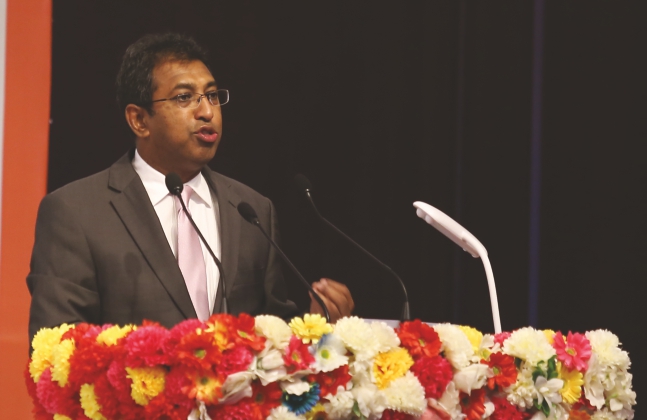Even though I have been to Dhaka many times since 1997, this is the first visit in my official capacity as a Minister of the Government of Sri Lanka. I am most impressed at how Bangladesh is developing under the astute leadership of H.E. Sheikh Hasina, MP, Hon’ble Prime Minister, People’s Republic of Bangladesh. A recent World Bank report titled ‘A Glass Half Full: The Promise of Regional Trade in South Asia,’ reveals that we in South Asia are nowhere near our potential in regional trade. In fact, given the proximity and size of our economies, the authors conclude that we should be trading three times more among ourselves than the current levels.
The cost of trade is disproportionately high in our region; 20 per cent more than country pairs in ASEAN and three times higher than corresponding costs among NAFTA, renamed USMCA countries. We all know that SAFTA is still far from achieving the goal of tarifffree trade. Most of us have lowered tariffs, but at the same time, many of us have adopted opaque para-tariffs contributing to SAFTA’s under performance.
Categorizing large numbers of HS codes in to sensitive lists, various port restrictions and tough visa regimes have all added to this suboptimal outcome. Integration of trade among our South Asia must be looked at as being complementary and as a stepping stone for deeper global integration. Such a strategy would not only create more wealth in all our nations, but, allow our people to consume at much more affordable prices than at present.
If we are serious about regional trade, then, we must consider the barriers to achieving our objective. The first is, border tax distortions. Related to this is to rationalize para-tariffs and sensitive lists. Second, we must reduce as much as possible non-tariff barriers. Here, improving information flows and establishing procedures and infrastructure; say, for improving the efficiencies in registration, laboratory testing and authorization etc. is absolutely essential. We hear stories of how efficient players in one country become totally inefficient in another in our own region due to these non-tariff barriers.
Third is connectivity costs: Here, besides infrastructure inadequacies, businesses have to deal with complex customs procedures and heavy compliance costs, sometimes extracted as rents by corrupt officials. And fourth is trust deficits. We must address the trust deficits among our nations by reinforcing the virtuous circle between trade and trust.
While Sri Lanka is identified as a South Asian nation, for us, we are more an Indian Ocean nation.
“Sri Lanka and Bangladesh have almost finalized a bilateral coastal shipping agreement to boost trade, investment and maritime connectivity between Dhaka and Colombo.”
Our government has set specific targets to place the port of Colombo within the top 20 container ports in the world by 2020 and to more than double the maritime contribution to GDP by 2030. At present Colombo is the only deepwater container port in South Asia that is able to accommodate large vessels of 18,000 teus or more. The CICT Terminal has a depth of 18 meters, compared to 14 meters at JNPT and 9 meters at Chittagong Port.
Sri Lanka and Bangladesh have almost finalized a bilateral coastal shipping agreement to boost trade, investment and maritime connectivity between Dhaka and Colombo. It will increase the frequency of feeder services between the ports of Chittagong and Colombo to cut down both the transshipment cost and time, boosting competitiveness, especially for the apparel industry.
I invite the Bangladesh government to engage with us in a dialogue to map out a strategy to take advantage of the changing landscape and commit to liberalize the industry in such a way that our citizens can benefit from enhanced trade among our nations.







